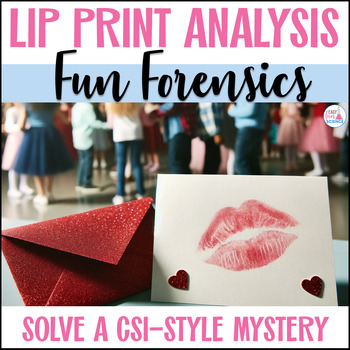Valentine's Day Forensic Science Crime Scene Investigation (CSI) Activity
- Zip
What educators are saying
Also included in
- Forensic Science Activities are a fun, yet educational, way to celebrate holidays without sacrificing instruction time in Middle School. This collection of forensic science crime scene investigation (CSI) activities includes 4 engaging laboratory activities that infuse the excitement of holidays wiPrice $12.80Original Price $16.00Save $3.20
- Students LOVE the intrigue of CRIME SCENE INVESTIGATION! This 8-pack of Forensic Science Lesson Plans is the perfect addition to your curriculum, created for upper elementary and middle school students. They will love these not-scary mock crime scene activities! These CSI activities are easy to setPrice $22.00Original Price $32.00Save $10.00
- These SUPER fun and easy-to-step-up Valentine's Day STEM Activities are the perfect way to celebrate Valentine's Day with your science students. Students will love this collection of activities that do not sacrifice learning for fun. This bundle includes games, hands-on activities, decorations, andPrice $16.00Original Price $23.40Save $7.40
Description
Your students will love this Valentine's Day Forensic Science Crime Scene Investigation (CSI) activity that uses LIP PRINTS to solve a mystery! This activity is a perfect way to celebrate Valentine's Day without sacrificing valuable instructional time. This activity is low-prep, NGSS-aligned and fun for kids! AND.... Unlike other forensics activities, this lab will not give your students nightmares! In Fun Forensics activities, no one dies!!!
NOW INCLUDES HIGHT SCHOOL VERSION!
This activity is perfect for traditional classrooms, enrichment programs/camps, homeschool co-ops, and homeschool students. This is a great alternative to graphic or scary CSI activities. This lab is easy to set up and uses common materials you can easily find at your local grocery store. Tested and approved by my students - this is a FUN activity that your students will love!
Here is the scenario:
Every February, Heartfield Middle School holds its annual Valentine’s Day dance. The principal, Mr. Stevens, holds an event crowning the Middle School “King and Queen of Hearts.”
On the night of the dance, the gym buzzed with anticipation. It was time for the students to find out who would be crowned as the King and Queen of Hearts this year. The music slowed and the lights in the gymnasium were turned on as Mr. Stevens was to reveal the lucky students.
As Mr. Stevens opened the red, glittery envelope, he gasped. The paper with the names of the winning students was missing!! The only thing in the box was a piece of paper with bright red lip prints.
What will students do in the Crime Scene Investigation?
- Learn how scientists use lip print analysis to solve crimes
- Collect and analyze their own lip prints
- Examine mock crime scene evidence
- Solve a Valentine's Day forensic science mystery
What will students learn?
- Students will learn about the role of forensic science in criminal investigations, with a focus on how unique physical characteristics, like lip prints, are used for identification.
- Students will understand that each individual has unique biological features, such as lip prints, similar to fingerprints, and how these features can be used in identifying individuals.
- Students will enhance their ability to observe detailed patterns and differences in lip prints, which is a critical skill in forensic science.
- Students will gain experience in collecting data by creating lip prints, and then analyzing these prints to identify distinct patterns and characteristics.
- Through analyzing lip prints and comparing them to solve a mock crime, students will enhance their critical thinking and problem-solving abilities.
- By participating in a mock investigation, students will see the application of scientific concepts in real-world scenarios, enhancing their understanding of the relevance of science in everyday life.
This product includes the following:
- FUN mysterious story to set the scene
- Background information for teaching
- Lists of materials
- Preparation instructions
- Three student articles
Lip Print Pattern Diagram - Lip Shapes Diagram
- Student instructions
- Lab report with spaces
- Follow-up questions and answer key
This activity supports the following NGSS:
- MS-LS1-3
- MS-LS1-5
Looking for more Fun Forensics activities? Check out...
- Forensic Science Urinalysis Crime Scene Investigation
- Forensic Science Chromatography Crime Scene Investigation (CSI) Activity
- Mystery Powders Forensic Science Crime Scene Investigation (CSI) Activity
- Forensic Science Fingerprinting Crime Scene Investigation (CSI) Activity
- Halloween Forensic Science Crime Scene Investigation Blood Spatter Activity
- Thanksgiving Forensics CSI DNA Extraction and Fingerprinting Gel Electrophoresis
- Forensic Science Christmas Activity Crime Scene Investigation & Fat Analysis
FUN FORENSICS BUNDLES:
- Fun Forensics Mega Bundle of 4 (Urinalysis, Mystery Powders, Chromatography, Fingerprinting, Halloween, Thanksgiving, Christmas/Holiday, Valentine's Day)
- Fun Forensics Bundle of 4 (Urinalysis, Mystery Powders, Chromatography, Fingerprinting)
- Holiday Crime Scene Investigation Bundle of 4 (Halloween, Thanksgiving, Christmas/Holiday, Valentine's Day)
Looking for more fun Valentine's Day Science Activities.... Check out these resources:
- Valentine's Day Science Animal Courtship Two Truths and a Lie
- Valentine's Day Science Crossword Puzzle
- Valentine's Day Science Bingo
- Valentine and Science Experiment Printable Card from Teacher
- Science Valentine's Day Cards from Teacher to Student - Famous Scientists
- Valentine's Day Bulletin Boards for Science Featuring Famous Scientists
- Valentine's Day STEM Paper Helicopter
- Hashtag Block Valentine's Day Cards from Teacher to Student
SAVE $$ With Holiday Bundles:
- Science Valentine's Day Cards and Bulletin Board Posters
- Valentine's Day Science No Prep Bundle of Games and Activities
- Valentine's Day & Holiday Crime Scene Investigation Growing Bundle
- Valentine's Day STEM Big Bundle
Follow Easy Fun Science on Instagram for updated lessons, STEM Your Faith, ideas for teaching in the classroom/homeschool, and science experiment hacks!!
Check out my blogs and contact me directly at EasyFunScience.com








